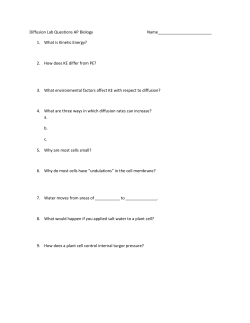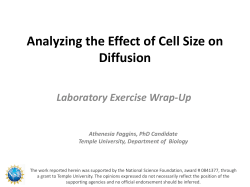
Introduction to Mass Transfer
Introduction to Mass Transfer Outline 1. Mass Transfer Mechanisms 1. Molecular Diffusion 2. Convective Mass Transfer 2. Fick’s Law for Molecular Diffusion 3. Molecular Diffusion in Gases 1. Equimolar Counterdiffusion 2. Combined Diffusion and Convection 3. Uni-component Diffusion Mass Transfer Mechanisms 1. Convective Mass Transfer 2. Diffusion http://www.timedomaincvd.com/CVD_Fundamentals/xprt/xprt_conv_diff.html Mass Transfer Mechanisms 3. Convective and Diffusion http://www.timedomaincvd.com/CVD_Fundamentals/xprt/xprt_conv_diff.html Outline 1. Mass Transfer Mechanisms 1. Molecular Diffusion 2. Convective Mass Transfer 2. Fick’s Law for Molecular Diffusion 3. Molecular Diffusion in Gases 1. Equimolar Counterdiffusion 2. Combined Diffusion and Convection 3. Uni-component Diffusion Fick’s Law for Molecular Diffusion We’ll first consider diffusion of molecules when the bulk fluid is not moving… For a binary mixture of A and B ∗ 𝐽𝐴𝑧 𝑑𝑐𝐴 = −𝐷𝐴𝐵 𝑑𝑧 𝑑𝑐𝐴 = 𝑑 𝑐𝑥𝐴 = 𝑐𝑑𝑥𝐴 ∗ 𝐽𝐴𝑧 𝑑𝑥𝐴 = −𝑐𝐷𝐴𝐵 𝑑𝑧 Molecular Transport Equations RECALL: driving force rate of transport = resistance d(v x ) yx dy MOMENTUM qy A d( c p T) HEAT dy J DAB * Ay MASS dcA dy Fick’s Law for Molecular Diffusion Example A mixture of He and N2 gas is collected in a pipe at 298 K and 1 atm total pressure which is constant throughout. At one end of the pipe at point 1 the partial pressure pA1 of He is 0.60 atm and at the other end 0.2 m pA2 = 0.20 atm. Calculate the flux of He at steady state if DAB of the He-N2 mixture is 0.687 x 10-4 m2/s. Convective Mass Transfer Coefficient For fluids in convective flow… 𝑁𝐴 = 𝑘𝑐 (𝐶𝐿1 − 𝐶𝐿𝑖 ) 𝑁𝐴 = 𝑘𝐺 (𝑝𝐴1 − 𝑝𝐴𝑖 ) 𝑁𝐴 = 𝑘𝑦 (𝑦𝐴1 − 𝑦𝐴𝑖 ) 𝑘𝑐 is very similar to h, What factors influence 𝑘𝑐 ? Outline 1. Mass Transfer Mechanisms 1. Molecular Diffusion 2. Convective Mass Transfer 2. Fick’s Law for Molecular Diffusion 3. Molecular Diffusion in Gases 1. Equimolar Counterdiffusion 2. Combined Diffusion and Convection 3. Uni-component Diffusion Molecular Diffusion in Gases Equimolar Counterdiffusion A B A B Flux of one gaseous component is equal to but in the opposite direction of the second gaseous component ∗ 𝐽𝐴𝑧 = ∗ −𝐽𝐵𝑧 Molecular Diffusion in Gases Equimolar Counterdiffusion At constant pressure,𝑃 = 𝑝𝐴 + 𝑝𝐵 A B Then, 𝑐 = 𝑐𝐴 + 𝑐𝐵 and 𝑑𝑐𝐴 = −𝑑𝑐𝐵 Fick’s law for B, A B ∗ 𝐽𝐵𝑧 𝑑𝑐𝐵 = −𝐷𝐵𝐴 𝑑𝑧 Molecular Diffusion in Gases Equimolar Counterdiffusion Substitution of Fick’s law A B into the equation for equimolar counter diffusion, ∗ ∗ 𝐽𝐴𝑧 = −𝐽𝐵𝑧 A B 𝑑𝑐𝐴 𝑑𝑐𝐵 −𝐷𝐴𝐵 = −(−𝐷𝐵𝐴 ) 𝑑𝑧 𝑑𝑧 Molecular Diffusion in Gases Equimolar Counterdiffusion A B 𝑑𝑐𝐴 𝑑𝑐𝐵 −𝐷𝐴𝐵 = −(−𝐷𝐵𝐴 ) 𝑑𝑧 𝑑𝑧 𝑑𝑐𝐴 𝑑𝑐𝐴 −𝐷𝐴𝐵 = −(−𝐷𝐵𝐴 (− )) 𝑑𝑧 𝑑𝑧 A B 𝐷𝐴𝐵 = 𝐷𝐵𝐴 Molecular Diffusion in Gases Equimolar Counterdiffusion For gases, A A 𝑐𝐴1 𝑝𝐴1 𝑛𝐴 = = 𝑅𝑇 𝑉 ∗ 𝐽𝐴𝑧 𝐷𝐴𝐵 𝑑𝑝𝐴 =− 𝑅𝑇 𝑑𝑧 B B Molecular Diffusion in Gases Equimolar Counterdiffusion In terms of mole fraction, A B 𝑐𝐴 = 𝑐𝑥𝐴 ∗ 𝐽𝐴𝑧 A B 𝑑𝑥𝐴 = −𝑐𝐷𝐴𝐵 𝑑𝑧 Molecular Diffusion in Gases Example A large tank filled with a mixture of methane and air is connected to a second tank filled with a different composition of methane and air. Both tanks are at 100 kN/m2 and 0°C. The connection between the tanks is a tube of 2 mm inside diameter and 150 mm long. Calculate the steady state rate of transport of methane through the tube when the concentration of methane is 90 mole percent in one tank and 5 mole percent in the other. Assume that transport between the tanks is by molecular diffusion. The mass diffusivity of methane in air at 0°C and 100 kN/m2 is 1.57 x 10-5 m2/s. Molecular Diffusion in Gases Diffusion plus Convection 𝑣𝐴 = 𝑣𝐴𝑑 + 𝑣𝑀 𝑣𝑀 𝑣𝐴 𝑣𝐴 = 𝑣𝐴𝑑 + 𝑣𝑀 𝐽𝐴∗ = 𝑣𝐴𝑑 𝑐𝐴 Multiplying by 𝑐𝐴 , 𝑐𝐴 𝑣𝐴 = 𝑐𝐴 𝑣𝐴𝑑 + 𝑐𝐴 𝑣𝑀 𝑁𝐴 = 𝐽𝐴∗ + 𝑐𝐴 𝑣𝑀 Molecular Diffusion in Gases Diffusion plus Convection 𝑁𝐴 = 𝐽𝐴∗ + 𝑐𝐴 𝑣𝑀 𝑣𝑀 𝑣𝐴 𝑣𝐴 = 𝑣𝐴𝑑 + 𝑣𝑀 𝐽𝐴∗ = 𝑣𝐴𝑑 𝑐𝐴 𝑁𝐴 𝐽𝐴∗ 𝑐𝐴 𝑣𝑀 Total convective flux of A wrt stationary pt Diffusion flux wrt moving fluid Convective flux wrt to stationary point Molecular Diffusion in Gases Diffusion plus Convection 𝑁 = 𝑐𝑣𝑀 = 𝑁𝐴 + 𝑁𝐵 Solving for 𝑣𝑀 , 𝑁𝐴 + 𝑁𝐵 𝑣𝑀 = 𝑐 𝑁𝐴 = 𝐽𝐴∗ + 𝑐𝐴 𝑣𝑀 Replacing 𝐽𝐴∗ and 𝑣𝑀 , 𝑁𝐴 = 𝑑𝑥𝐴 −𝑐𝐷𝐴𝐵 𝑑𝑧 + 𝑁𝐴 +𝑁𝐵 𝑐𝐴 ( ) 𝑐 Molecular Diffusion in Gases Diffusion plus Convection 𝑁𝐴 = 𝑑𝑥𝐴 −𝑐𝐷𝐴𝐵 𝑑𝑧 + 𝑁𝐴 +𝑁𝐵 𝑐𝐴 ( ) 𝑐 Molecular Diffusion in Gases Uni-component Diffusion One component (A)diffuses, while the other (B) remains stagnant Since B cannot diffuse, 𝑁𝐵 = 0 http://sst-web.tees.ac.uk/external/U0000504/Notes/ProcessPrinciples/Diffusion/Default.htm Molecular Diffusion in Gases Uni-component Diffusion Since B cannot diffuse, 𝑁𝐵 = 0 𝑁𝐴 = 𝑑𝑥𝐴 −𝑐𝐷𝐴𝐵 𝑑𝑧 + 𝑁𝐴 +0 𝑐𝐴 ( ) 𝑐 http://sst-web.tees.ac.uk/external/U0000504/Notes/ProcessPrinciples/Diffusion/Default.htm Molecular Diffusion in Gases Uni-component Diffusion 𝑑𝑥𝐴 𝑁𝐴 𝑁𝐴 = −𝑐𝐷𝐴𝐵 + 𝑐𝐴 𝑑𝑧 𝑐 𝑐𝐷𝐴𝐵 𝑑𝑥𝐴 𝑁𝐴 = − 𝑥𝐵 𝑑𝑧 http://sst-web.tees.ac.uk/external/U0000504/Notes/ProcessPrinciples/Diffusion/Default.htm Molecular Diffusion in Gases Uni-component Diffusion When P is constant, 𝐷𝐴𝐵 𝑃 𝑑𝑝𝐴 𝑝𝐴 𝑁𝐴 = − + 𝑁𝐴 𝑅𝑇 𝑑𝑧 𝑃 𝐷𝐴𝐵 𝑃 𝑑𝑝𝐴 𝑁𝐴 = − 𝑅𝑇𝑃𝐵 𝑑𝑧 http://sst-web.tees.ac.uk/external/U0000504/Notes/ProcessPrinciples/Diffusion/Default.htm Molecular Diffusion in Gases Example Water in the bottom of a narrow metal tune is held a t a constant temperature of 293 K. The total pressure of air (assumed dry) is 1.01325 105 Pa and the temperature is 293 K. Water evaporates and diffuses through the air in the tube, and the diffusion path z2-z1 is 0.1524m long. Calculate the rate of evaporation of water vapor at 293 K and 1 atm pressure. The diffusivity of water in air is 0.250 x 10-4 m2/s. Assume that the system is isothermal. Long Exam Results LE 1 LE 2 Mean 33.32 36.55 Median 32.00 30.75 Mode 39.00 25.50 Passing Rate 0.00 9.09 Student No. 2011-18077 2011-57319 2010-04141 2010-01283 2010-31873 2011-07217 2011-03676 2010-36588 2011-18143 2011-18147 2011-09522 2011-30507 2011-09270 2010-53270 2011-14930 2009-21119 2011-21884 2011-19280 2011-26790 2010-21409 2011-01530 2011-30255 Quizzes Total Q 5/5 30 46 36 26 47 26 50 23 31 31 33 23 19 36 61 8 48 9 104 14 57 21 1.50 2.30 1.80 1.30 2.35 1.30 2.50 1.15 1.55 1.55 1.65 1.15 0.95 1.80 3.05 0.40 2.40 0.45 5.20 0.70 2.85 1.05 Machine Problems Total* M 15/15 240 240 240 240 240 240 240 240 240 240 240 240 240 240 240 240 240 240 240 240 240 240 12 12 12 12 12 12 12 12 12 12 12 12 12 12 12 12 12 12 12 12 12 12 Target Average Scores LE3 L 60/60 Final F 20/20 82 90 82 89 85 67 93 92 73 77 102 88 81 74 51 99 70 92 45 100 65 91 30.4 27.8 31 29.1 29 33.3 26.9 28.7 31.9 31.3 26 29.6 30.9 31.6 35 28.1 32.1 29.5 34.1 27.3 32.5 28.9 82 90 82 89 85 67 93 92 73 77 102 88 81 74 51 99 70 92 45 100 65 91 16.4 18.0 16.4 17.8 17.0 13.4 18.6 18.4 14.6 15.4 20.4 17.6 16.2 14.8 10.2 19.8 14.0 18.4 9.0 20.0 13.0 18.2
© Copyright 2025









